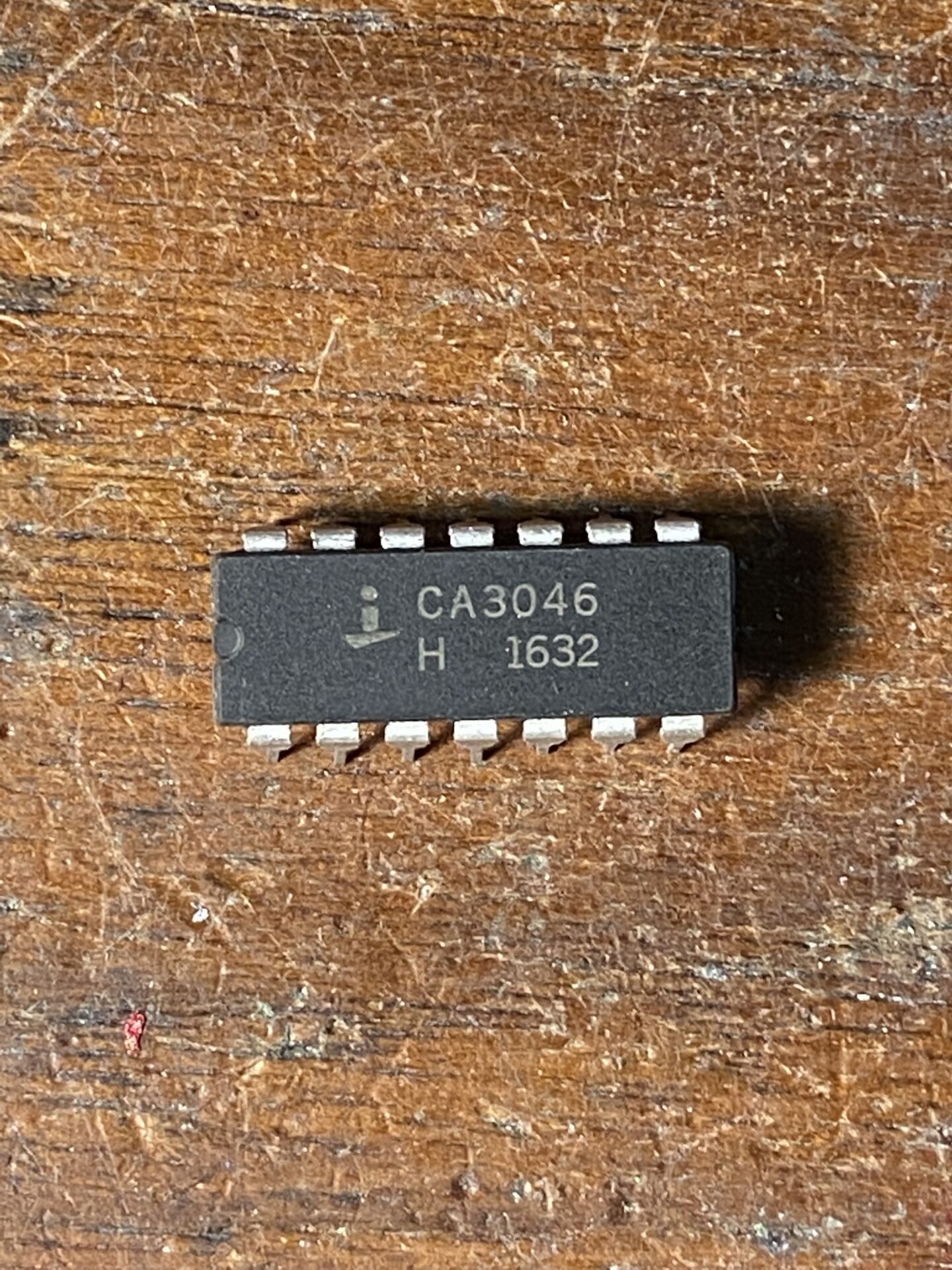The CA3046 is a 14 pin DIP that contains 5 NPN transistors. CA3086 and CA3045 are the same chip with a different number and some other esoteric differences. There is also an LM3046 and LM3086, same chip different manufacturer.


What is a transistor array?
The CA3046 contains 5 NPN transistors in a single 14 pin DIP. The transistors are described as ”general purpose” types. Think of it as 5 2N3904 transistors in one device.
But how can you have 5 three pin transistors in a single chip with only 14 pins? Two of the transistors share one pin at their emitters. This means certain uses for all transistors may not be possible.

Notice pin 3. The emitters of Q1 and Q2 share this pin.
What is the substrate?
Not sure to be honest. But you must connect this to ground or the point closest to ground in your circuit. Figure if you are not using Q5 you can connect connect pin 5 to ground.
If you are using Q5 use it for the transistor with the smallest emitter resistor. In some cases you may have a transistor with no emitter resistor and the emitter connects directly to ground, Q5 could be used there.
What is the differential pair?
A differential amplifier is a circuit building block that amplifies the difference between its two inputs. It can reject signals that appear at both inputs. Think about an op-amp.
With transistors a differential amplifier can be created by connecting the emitters of two NPN transistors together. Which is what we have in the CA3046!
What can you make with differential amplifiers? In guitar pedals its most often Octave effects and crossover distortion.
Here is a great explanation of differential amplifiers:
Another video with some great demonstrations:
What type of transistors?
The transistors are NPN types similar two 2N3904. The data sheet describes them as having a minimum beta (hFE) of 40 and average beta of 100. That’s pretty low.
I tested one of the transistors in one of the chips and it measured 75. Below average 😕.

The difference is that all of the transistors are all made from the same piece of silicon. This guarantees that they will have the same electrical characteristics. If you were looking for matched transistors you couldn’t find a closer match in a bag of 100 discreet 2N3904 transistors.
What can you make with a transistor array?
Anything that uses one or more NPN low gain transistors. If you’re going to use all 5 transistors it will have to be a circuit where the emitters of the two of the transistors can be tied together.
Here is a list of circuit ideas:
Retro Channel Fuzz is a Tone Bender like circuit that is built around the CA3046.
Tremolo-Matic XXII is a project from the Stompboxology newsletter: Going Discreet. It’s a tremolo that uses the CA3046 as a VCA.
The Big Muff is a classic fuzz circuit, I’m sure you’re familiar. Most versions use 4 NPN transistors. Some of the older versions used low gain devices.
The Fuzz Face is a classic circuit that uses two transistors. The original used two PNP types but there are plenty of NPN variants like the Meathead, and Woolly Mammoth.
The Tone Bender uses three transistors. The originals used PNP types but there are plenty versions that use NPN transistors.
Super Fuzz is an octave fuzz. There are many versions, related and derivative circuits. Some versions use 5 transistors and some use 6. What makes this a particularly good candidate for the CA3046 is all the circuits use two transistors tied together at the emitter! This is used to generate the octave and you’ll get a more pronounced octave effect if the transistors are matched.
Kay Fuzztone is an octave fuzz similar to the Super Fuzz but it uses only four transistors. It includes the two transistors tied at the emitter.
Brainstorming
Any of the circuits above would work and there are dozens more. I think you get the idea. Any circuit that uses a transistor would work with the CA3046. Keep in mind that you’d be using low gain NPN transistors. The device is a 14 pin DIP. Two of the transistors are connected at the emitter. Single or dual transistor circuits might be a waste but any circuit using 3, 4 or more NPN transistors might be fun.
Some of the examples above make better use of the CA3046 than others. The Super Fuzz and Kay Fuzztone are particularly good because they use the “differential pair.”
The Fuzz Face seems to be a bit of a waste since you’re only using 2 of the 5 transistors. In this case you could add an LPB-1 style booster with one transistor. This would be similar to an NPN the Fuzz Factory. You could build two Fuzz Faces in the same pedal with a booster!
Big Muff is a good use. Some of my favorite versions use lower gain chips. Gain is multiplicative. With four transistor stages the Big Muff can generate a lot of gain even with lower can transistors. But that still leaves one transistor unused. Why not swap one of the clipping stages with the octave section from the Super Fuzz?
Note the octave section of the Super Fuzz requires three transistors. One is used as a phase splitter and the matched differential pair are setup as a push push amplifier using the differential pair. So this idea might require a sixth transistor.
Experimental!
Everything below here has not been tested. I make no claims to the quality or accuracy of these schematics. These are just sketches of the ideas presented above. Use at your own risk!
I couldn’t find an Eagle part for the CA3046 so I’ve used discreet transistors and labeled the pin numbers.
Big Muff 3046

Octane/Kay Fuzztone 3046

Dual Fuzz Face 3046

Fuzz Face + Buzz Fuss 3046

Fuzz Factory like/Tone Benderish 3046


Leave a Reply